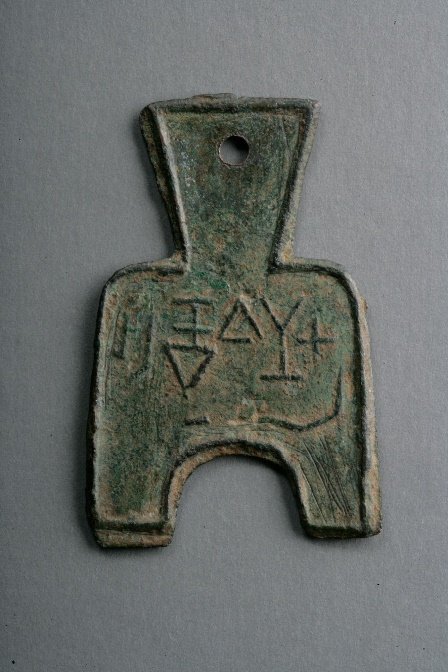Spade-shaped Coin with Arched Feet and the Inscriptions

The State of Wei (403-225 BCE) in the Warring States Period (475-221 BCE)
Overall length 5.8 cm, width 3.8 cm, weight 12.8 g
This spade-shaped coin is cast. It has a flat stem, arched shoulders, and squared-off feet, the feet being connected by an arch, hence its name. On one side there is an inscription written upside down and variously interpreted as "Shan Yijin"(陕一釿) or "Yu Yijin"(虞一釿). Both Shan and Yu are ancient place names. Scholars interpret the character Shan as currently a place located in the southwest of Shan County, Sanmenxia City, in Henan Province.
This coin type was the currency of the State of Wei during the Warring States period. It was the main kind of spade-shaped coin in Wei, and the inscriptions often contained the Chinese character "Jin", the unit of currency. It is, therefore, also called “a spade-shaped coin inscribed Jin."
The spade-shaped coin with arched feet was an early modification of the hollow-stemmed spade-shaped coin. The shape was not standardized, and there is no fixed formula for the content and arrangement of the inscription. The type has two main types of shoulder, flat and round. The inscriptions are sometimes written normally, sometimes written upside down, and sometimes written from the left. On the front face, the inscriptions generally recorded place names and denominations. And there are three main denominations: "Er Jin"(二釿), "Yi Jin"(一釿) and "Ban Jin"(半釿). The other side of the coin is mostly unadorned.
According to the research of ancient numismatists, although the spade-shaped coin with arched feet has three denominations of "Er Jin", "Yi Jin" and "Ban Jin", the systems actually used had only two denominations. At first, they were "Er Jin" and "Yi Jin"; later these gave way to "Yi Jin" and "Ban Jin." The disappearance of "Er Jin" and the emergence of "Ban Jin" were currency reforms driven by the reduced weight of the coins.
